Data consolidation is a process that combines data from various sources into a single, unified repository. It is a must if businesses want to analyze, share, and make decisions based on reliable data.
In this age of big data and cloud storage, consolidation has become crucial. As companies acquire systems and produce data every day, data becomes fragmented. This leads to inefficiencies and missed opportunities. Consolidation solves these problems.
This article will explore data consolidation and its types. We will also discuss techniques, steps, challenges, and best practices.
What is Data Consolidation?
Data consolidation merges data from databases, files, and applications to create a unified source of truth. This step is essential for deeper analysis, as it eliminates data silos and improves operational efficiency.
For example, a company wants to analyze its CRM, E-Commerce website, and Helpdesk data. To open the way for deeper analysis, data from these sources are consolidated into a staging area and then into a data warehouse. This is illustrated below:
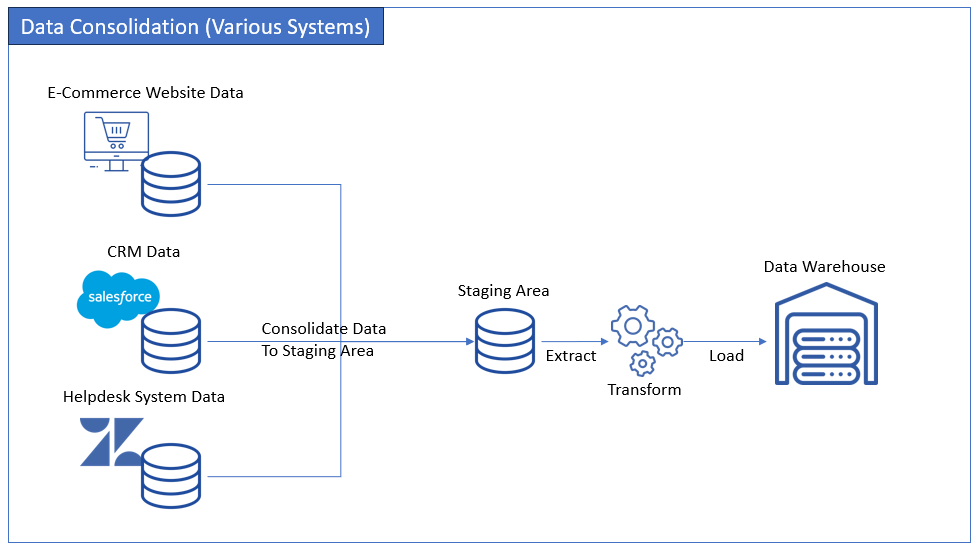
Another example is a company that has branches in different sales regions. Each region uses a relational database. To make consolidated reports possible, consolidating all data from these regions is a must.
See below:
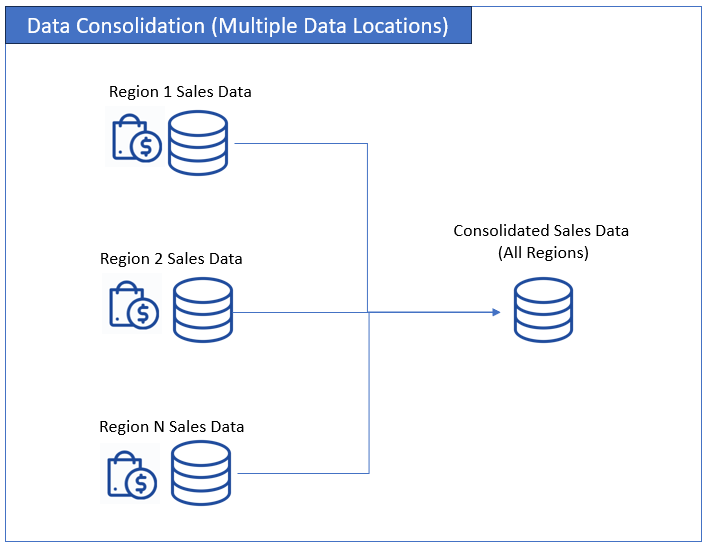
Consolidation can be confusing when compared with other data management processes like data integration, data warehousing, and data migration. All of these will move data and store results in a repository. Let's compare all of them with data consolidation.
Data Consolidation vs. Data integration
Traditional data integration typically involves combining data from different sources into a single system, like a data warehouse. It often starts with data consolidation, where data from multiple sources is combined into one place. However, not all data integration requires consolidation. Sometimes, data is just linked together without being combined.
For example, an e-commerce website has a database of customers, products, and purchases. Data integration is used to link these databases with a CRM system. In this case, the data is connected between the two systems but is not consolidated from various sources. See the diagram below:
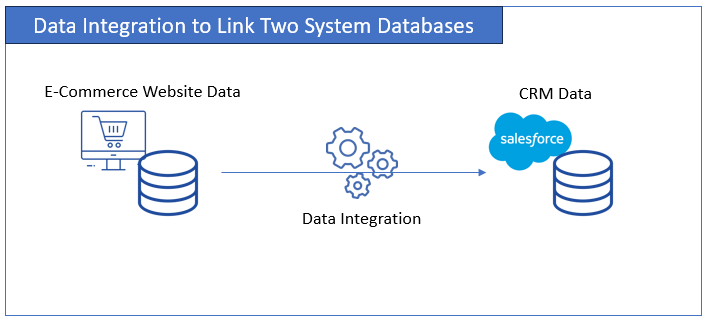
When the purpose is to analyze the e-commerce website and CRM data in a data warehouse, integration needs consolidation as the first step. This process combines the two data sources into a unified staging area. Then, further data integration processes ensure there is a clean, seamless update to the data warehouse regularly. Business intelligence tools will then use this data warehouse for analysis and decision-making. Check the diagram below:
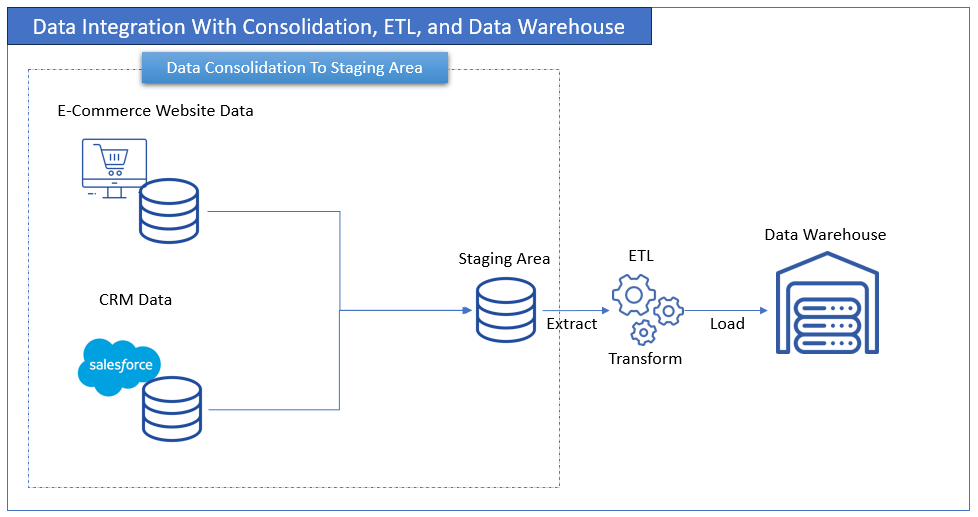
If consolidating any two or more sources is very straightforward, a staging area may be unnecessary. Consolidation results will end in the data warehouse.
Key Takeaways
- Data integration ensures a seamless connection between two or more systems or repositories. It may or may not involve consolidation.
- Integration may involve one or more data sources. Consolidation comes into play when more than one source is involved.
- If the goal is to analyze multiple sources, data integration will use consolidation as the first step in creating a unified repository.
Data Consolidation vs. Data Warehousing
Data warehousing is creating a centralized repository that is formatted and optimized for data analysis and reporting.
For example, management wants to analyze data from their ERP, CRM, and Helpdesk systems for data-driven decisions. The first step is to consolidate these three sources. Then, format it to a star schema fit for data warehousing. The entire process of extracting, formatting/cleaning, and loading relies on data integration. Below is an illustration using the three sources:
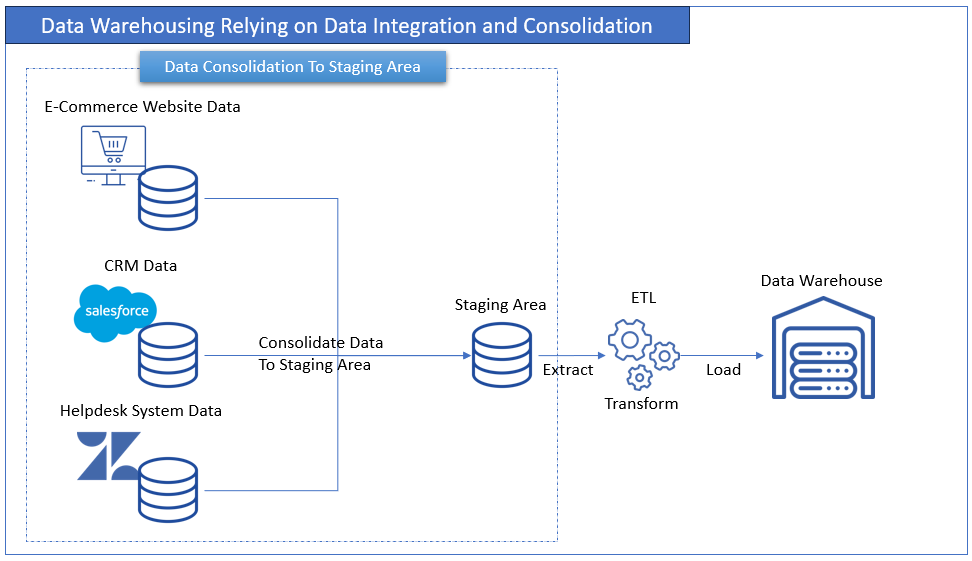 Key Takeaways
Key Takeaways
- Consolidation focuses on unifying various data sources. Data warehousing goes further to format and prepare data for analytical and strategic use. So, consolidation is the first step in data warehousing.
- Data warehousing result is a repository formatted for analysis, like a star schema. Consolidation alone may result in any other format.
- A data warehouse is the repository. Consolidation helps to prepare that single repository.
Data Consolidation vs. Data Migration
Data migration is the process of moving data from one system or location to another. It is usually done for system upgrades or replacements. If the source system uses multiple data stores, consolidation might be needed to meet the requirements of the target system.
For example, a company wants to move from a custom-built, legacy system for their customers to Salesforce. This will involve a relational database, a single source. Migration will involve formatting the relational data to Salesforce data formats. No consolidation is needed.
Key Takeaways
- Data migration may or may not use consolidation.
- It the data of the source system uses more than one repository, it may or may not need consolidation. It depends on the requirements of the target system.
Comparison Table
The following table summarizes the previous comparisons:
| Aspect | Data Consolidation | Data Integration | Data Warehousing | Data Migration |
|---|---|---|---|---|
| Definition | The process of combining data from multiple sources into a single, centralized repository. | The process of combining data from multiple sources to create unified datasets for analytics or to enable seamless data flow between systems. | The creation of a centralized repository designed and optimized for data analysis and reporting, often involving the consolidation of data. | The process of transferring data from one system or location to another, typically for system upgrades or replacements. |
| Objective | Create a unified dataset as a precursor for analysis and decision-making. | Ensure systems can communicate and share data effectively. | Store and organize large datasets for analysis and reporting. | Transfer data during upgrades, migrations, or system replacements. |
| Focus | Data unification. | Data connectivity. | Data storage for analytics. | Data relocation. |
| Output | A single, centralized repository. | Shared data across systems or a unified repository. | Analytical data ready for queries and reporting. | Data is available in the new system/location. |
| Examples | Merging CRM and ERP databases into a single repository; combining department-level datasets for analytics. | Real-time sync between inventory and sales systems; linking CRM and Helpdesk system. | Consolidating sales and marketing data for business intelligence tools; storing IoT data for trend analysis. | Moving on-premise databases to cloud systems; migrating customer data to a new CRM. |
| Tools/Technologies | ETL tools, database management systems (e.g., Skyvia, SQL, Talend). | Integration platforms (e.g., Mulesoft, Skyvia), REST APIs. | Data warehouses (e.g., Snowflake, Redshift, Azure SQL). | Migration tools (e.g., AWS Database Migration Service, Azure Migrate). |
| When to Use | When creating a comprehensive dataset for analysis is critical. | When systems need to share data in real-time, near-real-time, or batches. | When scaling analytics and reporting for large datasets. | When systems are being upgraded, replaced, or consolidated. |
Importance and Benefits of Data Consolidation
Consolidating data comes with benefits out of the box. That's why it's important for companies using several systems to consolidate the data. The following are the notable benefits:
Data Quality and Consistency
As organizations grow, they adopt new tools and systems. Each of these systems has its data repositories. Their data is scattered across these different repositories. Some systems have the same copies of products, customers, and other data entities. They are fragmented, duplicated, and may be in conflict. Without tools to unify them, data silos happen.
With data consolidation, these duplicates are merged and cleaned. Then, stores the results in a central repository. Another data process can eliminate the conflict from the central repository down to the source systems. The result is a cleaner, consistent data across different systems with one standard. The quality of data improves and so is the operations that revolve around them.
Example: A retailer consolidates inventory records from four warehouses. Because of the single, consistent view, the entire stock levels are more accurate. He avoided overstocking and stock outs.
Enhanced Decision-Making
With high-quality data in a centralized repository, decision-makers have a complete picture of the entire business. This makes advanced analytics, predictive modeling, and real-time reporting possible.
As a result, decision-making improves avoiding guesses and wrong conclusions.
Example: A healthcare provider improves treatment plans and patient outcomes by consolidating patient data from different departments to produce holistic insights.
Cost Savings
Technology continues to improve. Storage is also becoming cheaper. When a certain solution is more feasible and more cost-effective than existing ones, companies can take advantage. Along with technology improvements, consolidated data from different locations may be better.
This will simplify management and eliminate the cost for storage, maintenance, and integration. It will also streamline processes and reduce the manpower needed for maintaining fragmented data.
Example: A multinational firm consolidates regional sales data into one global system, cutting costs on regional IT infrastructure.
Increased Security
If the goal is to centralize data for day-to-day operations, it will simplify data management and security. Managing access controls, encryption, and even audit will only come from one repository.
Example: A financial institution consolidates transaction data, enabling stronger fraud detection and regulatory compliance.
Data Consolidation Techniques
Below are some of the most common methods of data consolidation.
ETL (Extract, Transform, Load)
ETL, which stands for Extract, Transform, Load, is a widely used technique for data consolidation. First, extract the data from multiple sources. Then, transform the extracted data based on the format dictated by the target. Finally, store the consolidated data in the target repository.
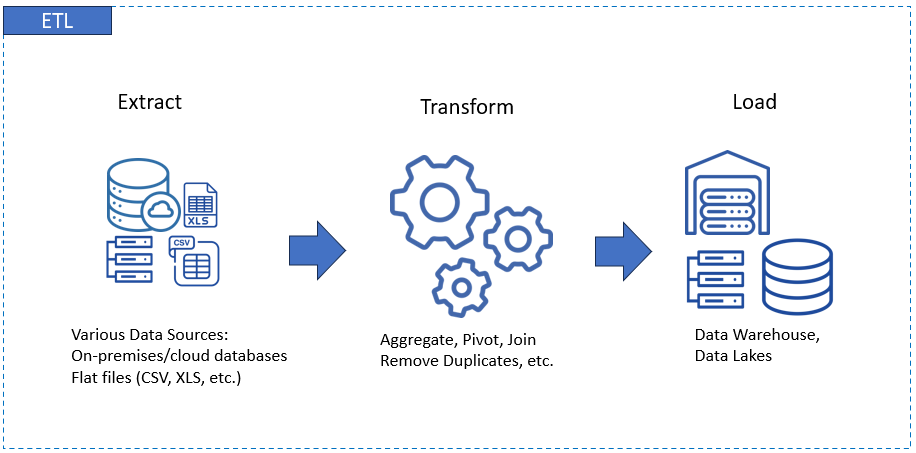
Benefits of ETL
- Automates data cleaning and transformation.
- Ensures data is in a consistent format for analysis.
- Handles complex data structures effectively.
ETL Examples
- Cirrus Insight needed a solution to merge two Salesforce accounts and sync data from QuickBooks, NetSuite, SQL Server, and others with Salesforce customer records and subscriptions.
- Alhena's challenge is to extract the list of leads from different car dealerships. They need to consolidate these lists and store them in their Salesforce CRM using ETL.
Data Warehousing
Data warehouses are centralized repositories of structured data. Companies can store consolidated data from various sources and systems in a data warehouse. This allows centralized reporting and analysis.
Benefits of Data Warehousing
- Optimized for querying and analytics.
- Supports advanced reporting, trend analysis, and decision-making.
Examples of Data Warehousing
- TitanHQ's challenge is to automate the data extraction from SugarCRM, Maxio, and a ticketing system to SnowFlake. There are 3 data sources combined, formatted, and stored in SnowFlake as the data warehouse.
- Convene needs to consolidate data from Marketo, Salesforce, and other file formats stored in Amazon S3. These various data sources will be combined for analysis in the Amazon Redshift data warehouse.
Data Lakes
Data lakes are repositories for storing raw and unstructured data. They are flexible in handling these file formats.
Benefits of Data Lakes
- Handles diverse formats (e.g., video, text, IoT).
- Ideal for big data and machine learning workflows.
Examples of Data Lakes
- An IoT company stores sensor data in a data lake to support AI-driven predictive maintenance.
- An AI-driven image generation stores user prompts, generated images, and user feedback in a data lake as data to improve future image generation.
Master Data Manamegent (MDM)
Master Data Management (MDM) is a comprehensive suite of data management processes used by organizations to create and maintain a single, accurate, and consistent master record for key business entities. This includes but not limited to customers, products, and suppliers.
Once data is unified and standardized, it can be used for centralized reporting, a 360-degree view of your data, and more.
Benefits of MDM
- Reduces duplication and inconsistencies.
- Ensures a "single source of truth" across departments.
Examples of MDM
- A bank consolidates customer data from multiple systems using MDM to improve personalization and compliance.
- A group of companies consolidated their seafarer information for ship crew management, travel tickets, and insurance.
Top Tools for Data Consolidation
There are many tools in the market that are capable of data consolidation. The top data consolidation tools are the following:
Skyvia
Skyvia is a flexible cloud-based data platform that offers ETL, data integration, replication, and more. It features a user-friendly interface and supports multiple databases and cloud services.
Apache Kafka
Apache Kafka is a real-time streaming platform ideal for consolidating and integrating data streams. It is open-source and developer-friendly, making it suitable for handling high-performance data streams.
Talend
Talend is a comprehensive ETL and data integration platform with robust transformation capabilities.
Informatica
Informatica is an advanced data management suite that includes ETL, MDM, and data governance features.
Steps to Implement Data Consolidation
This section will discuss the step-by-step data consolidation process. It involves 5 general steps as outlined below.
1. Define Objectives and Scope
What to Do
- Write down why data consolidation is needed—e.g., improving decision-making or streamlining operations. Be specific in the operations it will simplify and the decisions it will improve.
- Identify the data sources (databases, applications, or spreadsheets) and the desired end state.
Tips
- Involve stakeholders from all departments, including higher management, to align goals and avoid missing critical data sources.
- Create a roadmap outlining milestones and success metrics.
2. Select Data Consolidation Tools and Techniques
What to Do
- Evaluate tools and techniques (e.g., ETL, data warehouses, data lakes) based on factors like scalability, integration capabilities, ease of use, and cost.
- Consider cloud-based tools (e.g., Skyvia, Talend) for ease of use and scalability.
Tips
- Choose tools with data connectors compatible with existing systems to reduce implementation complexity.
- Factor in the volume and type of data when selecting techniques.
3. Data Preparation
What to Do
- Design the data flow.
- Standardize the data. Eliminate duplicates and inconsistencies.
- Validate the data for completeness and accuracy to ensure reliability in the consolidated system.
Tips
- Use data profiling tools to identify potential issues early.
- Establish standardized naming conventions across datasets.
4. Execution and Testing
What to Do
- Execute the chosen consolidation technique (e.g., ETL pipelines) and consolidate data into the central repository.
- Test for accuracy, completeness, and performance post-consolidation.
Tips
- Test with a small subset of data before full implementation to identify potential issues.
- Involve end users to verify the usability of consolidated data.
5. Monitor and Maintain
What to Do
- Regularly update and maintain the consolidated data to ensure accuracy over time.
- Monitor for changes in source systems that may impact the consolidation process.
Tips
- Automate monitoring with alerts for anomalies or failed updates.
- Periodically review and refine processes to adapt to evolving business needs.
Additional Tips for a Smooth Process
- Assign a dedicated team or project manager to oversee the process.
- Document each step for repeatability and compliance purposes.
- Start small by prioritizing critical data sources.
- Regularly communicate progress and issues to stakeholders.
Best Practices for Effective Data Consolidation
The following data consolidation best practices ensure a seamless and efficient data consolidation process. Sticking to these practices helps maintain data integrity, compliance, and long-term scalability.
Prioritize Data Quality Management
- Implement robust data validation processes to detect and resolve inaccuracies or duplicates during consolidation.
- Use automated tools to maintain consistency and avoid manual errors.
Regularly Review and Update Consolidation Practices
- Audit your consolidation workflows periodically to identify inefficiencies or outdated processes.
- Adjust practices as new data sources, technologies, or business needs emerge.
Ensure Compliance with Data Privacy Regulations
- Adhere to relevant laws, such as GDPR or HIPAA, when handling sensitive data during consolidation.
- Use encryption and access controls to protect data during transfers and storage.
Involve Stakeholders from Various Departments
- Collaborate with key personnel to understand their data needs and ensure all critical data sources are included.
- Facilitate cross-department communication to resolve potential conflicts or redundancies.
Challenges in Data Consolidation
While there are tools to consolidate data, it does not mean there are no more challenges. The following are the most common challenges met by data professionals in consolidating data.
Data Quality Issues
Merging data from separate sources will reveal inconsistencies, duplicates, or outdated information. Choosing which is the most accurate and latest is very challenging.
Failure to clean data will result in unreliable reports and wrong decisions.
Solution
- Implement data profiling tools to identify errors before consolidation.
- Use ETL processes with robust data cleansing and validation steps.
Data Silos
Fragmented data is already a problem but can be solved. Data silo elevates it more by making disparate sources inaccessible to others in the company. If some users keep data in spreadsheets apart from their main system, these spreadsheets are not accessible to others in the company. It will make it hard to integrate and unify.
Furthermore, users or owners of these data may resist sharing or giving up the data they worked hard for.
Solution
- Leverage cloud-based platforms like AWS or Snowflake that offer scalability on demand.
- Design solutions with scalability in mind, such as using modular ETL pipelines.
Security and Compliance
Consolidating data in one location, while beneficial, increases the risk of data breach. If not secured properly, combined data is easier to steal or destroy. Ensuring compliance with regulations like GDPR or HIPAA can also be complex.
Solution
- Use the latest encryption methods, access controls, and regular audits to secure data.
- Employ tools with built-in compliance features, such as Informatica or Microsoft Purview.
Conclusion
Data consolidation is important if a company aims to become competitive in a data-driven world. It enhances decision-making, uncovers insights, and simplifies processes. But remember that consolidation is not only about centralization, it also ensures data is usable and actionable.
In the future, artificial intelligence and machine learning can enhance data consolidation processes and steps. It will detect patterns, anticipate problems, and suggest a better workflow. These will make consolidation faster and more accurate.
Using the knowledge compiled in this article, evaluate your company's current data strategies and identify areas for improvement. Adapt new technologies and follow best practices to ensure a successful data consolidation.